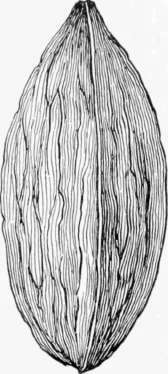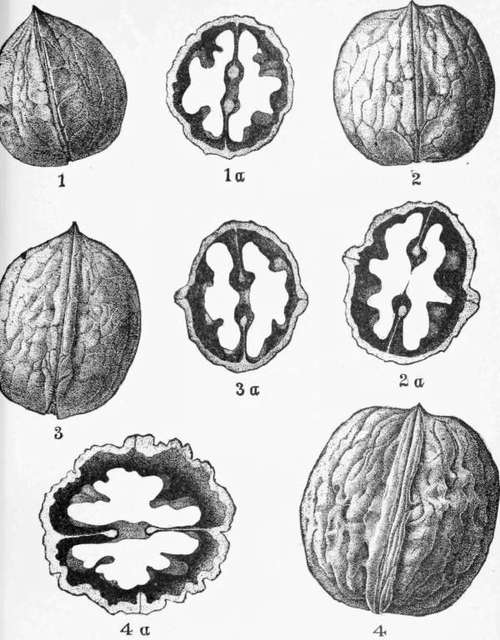Walnut
Description
This section is from the book "Guide For Nut Cookery", by Almeda Lambert. Also available from Amazon: Guide to nut cookery.
Walnut
Juglans is a Latin name contracted from Jovis glans, meaning the "nut of Jupiter." It is said that the name was first used by Pliny, a Roman writer of the time of Pompeii.
They are medium-sized deciduous trees, having alternate pinnate leaves of from fifteen to twenty-one leaflets. The seed-pod is two to four celled, but has only one ovule or nut.

Bearing Branch of English Walnut.
The nuts are round or oblong, with thin husks, which dry up without opening; the shell is either rough and deeply corrugated, or quite smooth; in some species quite thick, and in others quite thin. The kernel is two lobed and united at the apex; it is sweet, rich, and oily.

Chile Walnut.
The walnut of commerce is known by various names: English, French, Persian, European, and Italian; also there are the Madeira walnut, Chile walnut, and California walnut, named from the country in which they grow.
There are many species and varieties of walnuts. The principal ones that are natives of the United States are the butternut and the black walnut. Although butternuts differ in many respects,- in the tree, shell of the nut, and even in the flavor of the kernel, - yet it is placed by botanists with the walnuts. The nut is covered with a husk which it does not shed, but dries upon the deeply corrugated and very thick shell. The kernels are sweet and very tender, and oily, but are difficult to remove from the shell. For this reason, they are not highly esteemed. In composition, they are similar to the walnut, but contain rather more fat, and are quite as valuable for food when once removed from the shell.
The black walnut, botanically called Juglans Nigra, grows wild. The trees in many parts of the United States are large, with smooth leaflets, which are ovate, lanceolate, and serrate. The fruit is spherical in form, with hard, thick shells, deeply corrugated. The kernels come out quite hard, but in some varieties are much easier to remove than others. When removed from the shell, they sell in market for rather more than the English walnut.
Among the Oriental walnuts, or those indigenous to the Old World, there are also many varieties, as they have been cultivated and improved for so many hundred years. Many of them have been planted in the United States, especially in California, where they will soon be a paying business. The following are some of the best-known varieties :-
The Barthere Walnut.-This is a long nut, pointed at both ends, with a thin shell. The kernel is large and the flavor excellent.

Barthere Walnut.
The Chaberte. - This is an old standard French variety, of oval shape, medium sized, and kernels very full and rich flavored.
The Chile Walnut. - This name is given in a general way to all walnuts coming from South America. The nuts are good sized, thin, but firm shells, with plump kernels, having an excellent flavor. Many of the Chile walnuts have three valves instead of two.
The Gant Walnut. - This is a variety of remarkable size, but the kernel does not correspond to the size of the shell.
The Gibbon's Walnut. - This is a very large variety raised in France many years ago, but it is of little value, as the shell is very thick and the kernel small.
The Mayette Walnut. - A very large variety, with a light-colored shell of moderate thickness. The kernels are plump, readily extracted whole, and very sweet, with a rich, nutty flavor. This is an old standard French variety.
The Mesange or Paper-shelled Walnut. - This nut has the thinnest shell of any variety known. The kernels are plump and quite rich and oily, but they are more apt to be bad, as the shells are so easily broken; and when the kernel is exposed to the air, it readily spoils.
The Parisenne Walnut. - This variety originated in Southern France, but grows well in California. It is a large and broad variety and has a thin, but firm shell; the kernels have an excellent flavor.
The Serotina Walnut. - This is a very popular variety, as it buds late in the spring, escaping the late frosts, and grows so rapidly that it is ripe in the fall, with the other varieties.

Walnut Kernel.

Persian Walnuts
1. Mission; la. Section of Mission; 2. Procparturiens; 2a. Section of Procpartu-riens; 3. Mayelle; 3a. Section of Mayelle; 4. Franquette; 4a. Section of Fran-quette; 5. Chaberte; 5a. Section of Chaberte.

Persian Walnuts
1. Cluster; 1a. Section of Cluster; 2. Grand Noblesse; 2a. Section of Grand Noblesse; 3. Ford (soft-shelled); 3a. Section of Ford; 4. Gant; 4a. Section of Gant.

Miscellaneous Walnuts
Black Walnut (Juglans Nigra). - 1. Taylor: la. Section of Taylor; 2. Peanut; 3. Mirza; 3a. Section of Mirza; 4. Specimen from S. B. Cole. Japanese Walnuts. - 5. Juglans Mandshurica Maxim; 6. Juglans Cordiformis Maxim; 7. Juglans Sieboldiana. Hybrid Walnut, -8. Vilmorin,
It is medium sized, the shell rather hard, but the kernel is plump and well flavored.
Walnuts have been raised and highly valued from very early times. Pliny informs us that the Greeks called the tree Caryon, on account of the strong scent of the foliage. It is claimed by the early writers of Europe that the emperor Vitellius introduced the walnut into Italy. When the planting of walnuts was extended into Gaul (Ancient France), they were called "Gaul nuts," which the English-speaking people corrupted into "walnuts." Walnuts in this age were highly prized and considered appropriate only for the table of the king. They believed that they possessed powerful medical properties, even curing hydrophobia; but the medical fraternity of to-day are of a different opinion. The walnut is very nutritious, both in fats and albumen, making them an excellent nut to use in the preparation of foods. They contain fifteen and eight-tenths per cent, of albuminous elements, thirteen per cent, of starch, fifty-seven and four-tenths per cent. of fats, and two per cent, of salts; making a total nutritive value of eighty-eight and two-tenths per cent.
Continue to:


